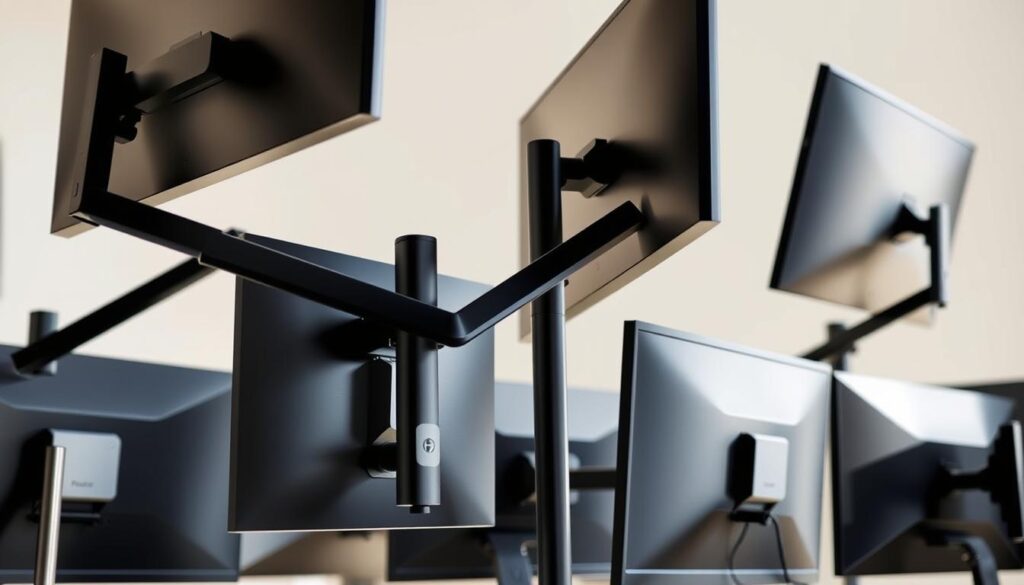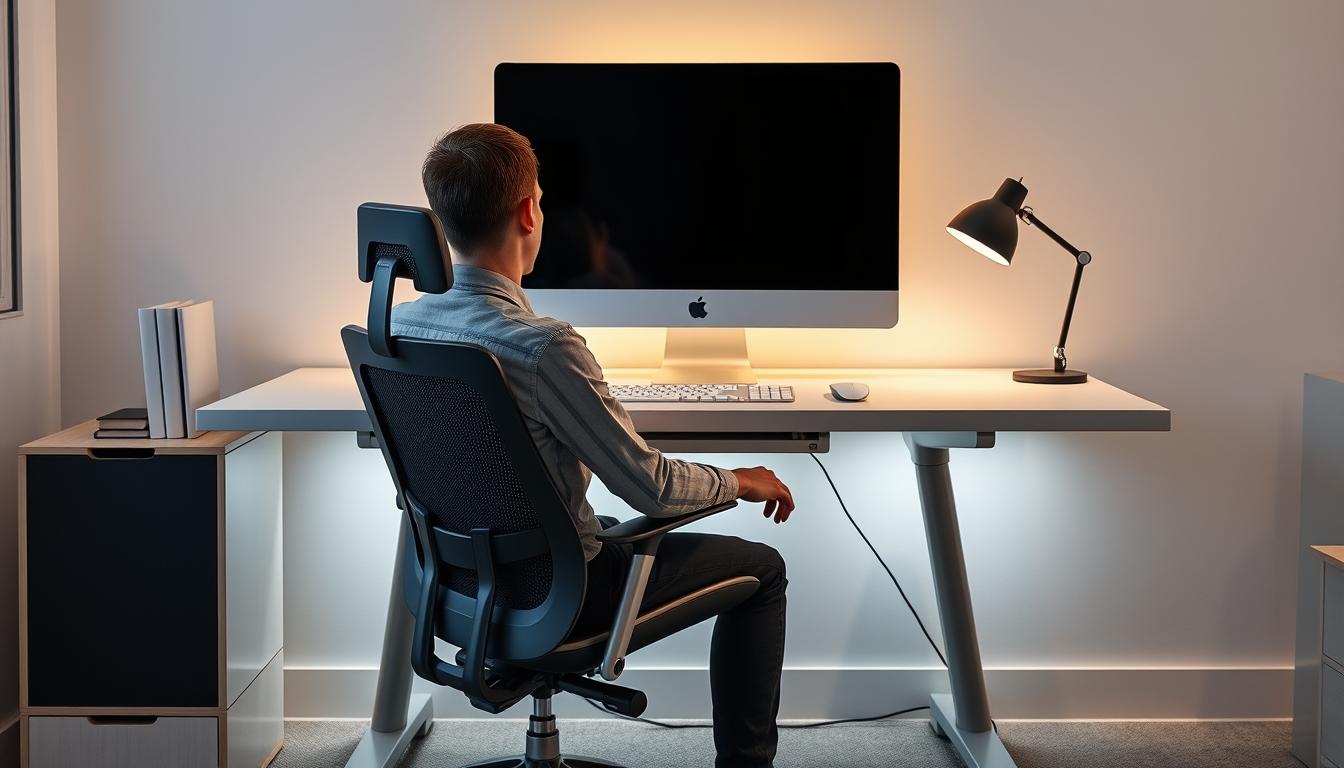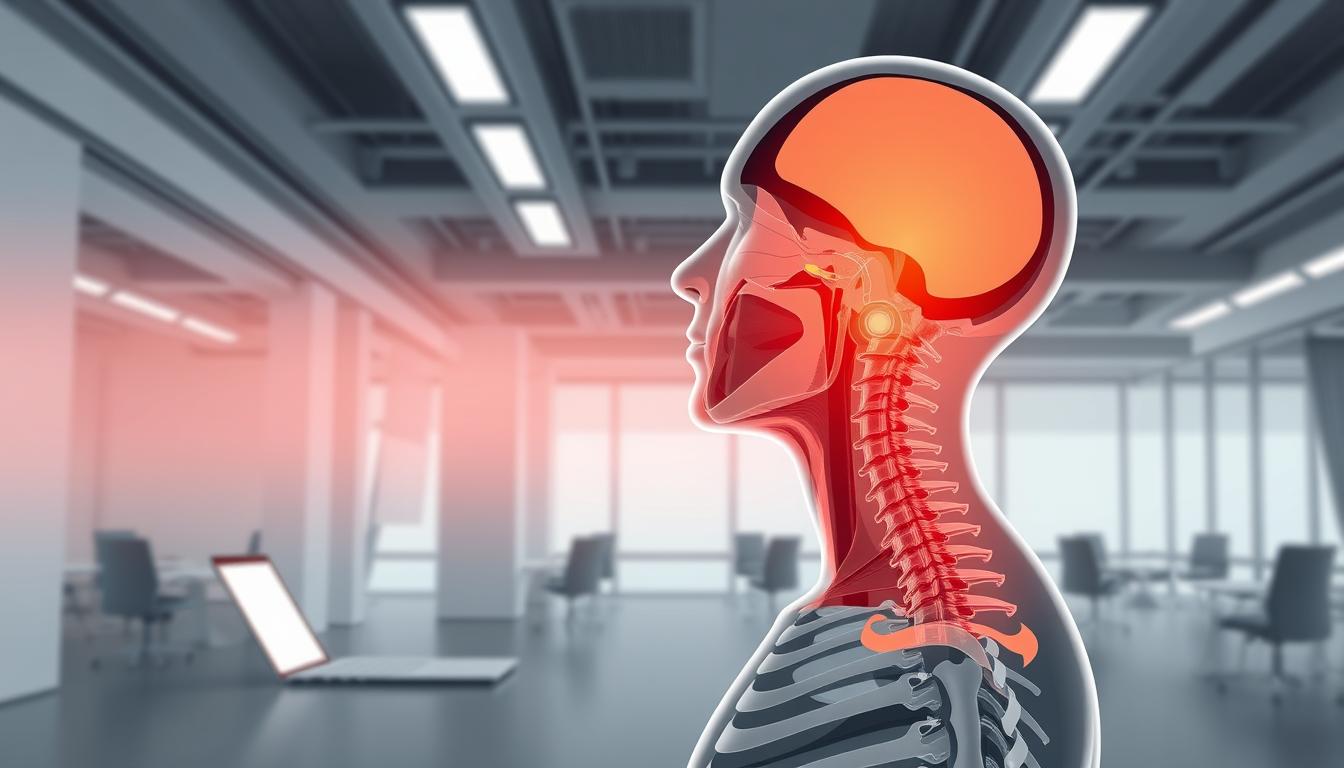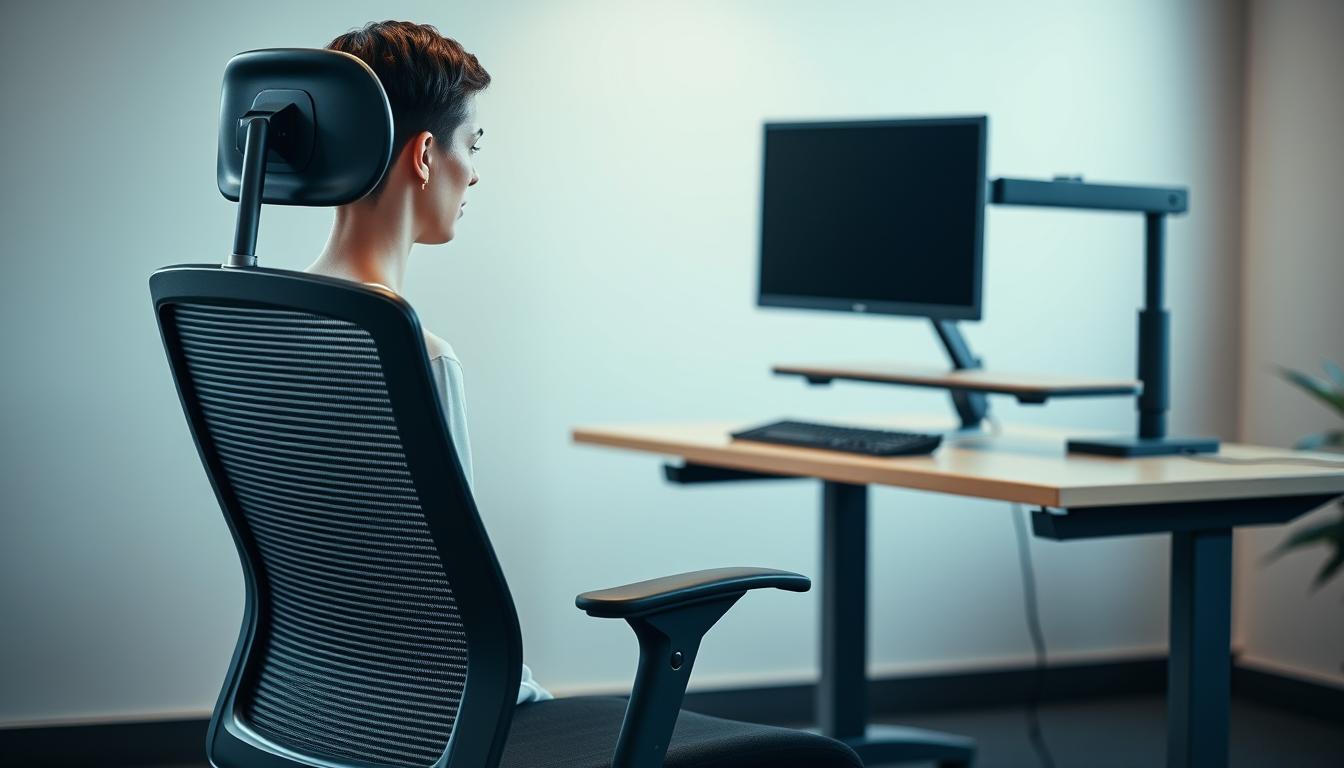Many professionals working from home are now dealing with neck pain. This issue often comes from poor home office setups and bad ergonomics. It’s vital to invest in top-notch ergonomic accessories for relief.
Choosing the right products for your office can ease neck tension greatly. This promotes a work space that’s healthier and boosts productivity. In this guide, we’ll look at ways to make your work area support your well-being.
The Rise of Neck Pain in the Remote Work Era
The COVID-19 pandemic has changed how we work, making more people work from home. This change has led to more people complaining about neck pain. As we adjust, many are using home setups that aren’t ideal, like dining chairs. These setups can make neck pain worse or cause new issues, like “tech neck.”
Many people still prefer working from home. This makes it important to fix ergonomic problems in home offices. Without the right support and alignment, you can feel uncomfortable. This can hurt your work and health. It’s crucial to use ergonomic solutions. This helps make sure working from home doesn’t harm your physical health.
Understanding Neck Tension: Causes and Symptoms
Neck tension often begins with poor posture during work or while relaxing. People usually slouch over their gadgets or sit wrongly, hurting their necks. The main reasons are staying in bad positions for too long and not having good support. This makes neck and shoulder muscles very tight and tired over time.
It’s important to know the signs of neck pain early. Stiffness, headaches, and even sharp pain could mean your neck needs help. With more people working in tough conditions, understanding and taking action against neck pain is key.
Why Your Home Office Setup Matters
An ergonomic home office is key to staying comfortable while you work long hours. It helps prevent neck pain and encourages good posture. If your space is cluttered or set up wrong, you might feel uncomfortable and less productive.
Here’s what you need for a great home office:
- Ergonomic chairs that support your back and encourage you to sit properly.
- Desks that can move up and down, so you can stand or sit as you work.
- Items like keyboard trays and monitor stands that keep everything at the right height.
Creating an ergonomic workspace helps a lot. It cuts down on physical discomfort and keeps you working well. By choosing the right furniture and layout, you can fight the negative effects of sitting too much. This will make your workday better and improve your health overall.
Essential Ergonomic Accessories to Reduce Neck Tension
To ease neck tension, picking the right tools is key. It all begins with a good ergonomic office chair. This chair is central for back support and keeping a good sitting posture. Besides the chair, using an ergonomic keyboard and mouse is vital too. They keep your wrists right and cut down strain when you use the computer a lot.
Choosing the Right Office Chair
Getting the right ergonomic office chair is about matching it to your needs. Look for a chair that lets you adjust its height, backrest angle, and how deep the seat is. These adjustments help you sit more comfortably, which is good for your spine. A chair that fits well also helps your blood flow better and keeps muscles from getting tired, especially when you sit for a long time.
Importance of an Ergonomic Keyboard and Mouse
Using an ergonomic keyboard and mouse can really change how you feel when computing. They are made to keep your wrists in a natural position. This lowers your chance of getting hurt from doing the same movements over and over. An ergonomic keyboard usually has a split design for easier typing. And an ergonomic mouse keeps your wrist comfortable, making long work hours feel easier.
Using a Standing Desk for Better Posture
A standing desk can make a big difference in how straight you stand. It lets you change your position through the day. This leads to sitting and standing more healthily, easing neck pain.
Benefits of Adjustable Standing Desks
Adjustable standing desks come with many perks. You’ll find yourself standing straighter, which lessens neck and back aches. You’ll also feel more awake and get more done because you’re moving more. Plus, moving around helps your blood flow better.
Best Practices for Switching Between Sitting and Standing
There are smart ways to use an adjustable desk for the most benefit. Remember this advice:
- Set your desk so your screen is at eye level. This helps keep your neck comfortable.
- Change from sitting to standing every 30 to 60 minutes to stay balanced.
- Use your core muscles while standing to support your spine and improve your posture.
Adjustable Monitors: Why Height Matters
Monitor height is key for a healthy workspace. It keeps you comfortable and stops neck strain. Adjustable monitors let you change your setup for better posture during long periods of computer use. Placing your monitor right can make you feel much better.
Setting Up Your Monitor at Eye Level
For the best ergonomic position, keep your monitor at eye level. It helps your neck stay in a natural position, easing fatigue and discomfort. The top of the screen should be at or just below eye level. Then, you can look down at the screen easily. This way, you can keep a relaxed posture and avoid neck tension.
Preventing Neck Strain with Proper Monitor Placement
Keeping neck strain away starts with where you put your monitor. It should be an arm’s length away. This stops you from straining your eyes and neck.
Being too close or too far away can make your neck hurt. If you use a laptop, try an adjustable monitor for better ergonomics. Making these changes helps you work more comfortably.

Ergonomic Accessories for Neck Pain Relief
For those wanting relief from neck pain, picking the right accessories is key. Ergonomic pillows are especially important for keeping your neck and spine lined up right. The correct neck pillow eases stress and helps you sleep better, improving your overall well-being.
Finding the Best Neck Pillows
To find the top neck pillows, focus on those made for ergonomic support. You should look for features like:
- Memory foam that shapes to your head and neck
- Different levels of firmness to match what you like
- A contour design for better support of your cervical spine
Ergonomic pillows that are high quality relieve muscle strain, especially if you work at a desk or travel a lot. They support your cervical spine, providing stability and helping you relax while you sleep.
Investing in Cushioned Support Pillows
Pillows with cushioned support are great for long-term use and can boost comfort wherever you are. These pillows often have features like:
- Materials that are soft yet offer support to lessen pressure points
- Portable designs that you can use at home or work
- The ability to adjust, fitting different body types and sitting styles
Choosing the right cushioned support pillows makes a big difference in your daily comfort. By focusing on ergonomic options, you’ll lower your neck tension. This can help you focus better and be more productive.
The Role of Frequent Breaks in Reducing Neck Tension
Breaks are very important in a workday, especially for reducing neck pain. Sitting too long can make your neck and shoulders hurt. Getting up to stretch or walk for a bit helps ease that pain.
Taking breaks often is good for your blood flow, especially to muscles that get sore from sitting. Doing simple stretches when you take a break can make you work better. You’ll feel refreshed and more focused, and your muscles won’t hurt as much from sitting too long.
- Stand and stretch for a few minutes every hour.
- Do neck rolls and shoulder shrugs to relieve tension.
- Take a brief walk to refresh both your body and mind.
Tips for Maintaining Good Posture Throughout the Day
Good posture is key to staying healthy, especially when you work long hours. Start with simple ergonomic tips to boost comfort and work better. Use these strategies to build good habits at work:
- Ensure that your feet rest flat on the floor. This provides stability and promotes a natural spine position.
- Adjust your chair to provide support for your lower back. Proper lumbar support can help maintain the natural curve of the spine.
- Keep your arms close to your body while typing. This reduces strain on the shoulders and prevents awkward arm positioning.
- Position your monitor at eye level to avoid leaning forward or tilting your head. A neutral spine helps reduce neck strain.
- Take frequent breaks to stand, stretch, and move around. This helps reset your posture and prevents stiffness.
Applying these tips daily can make you more comfortable and lower risks from bad posture. By paying attention to your position and making the right changes, you can make your workspace healthier and more productive.
Exercises to Alleviate Neck Tension
Adding neck exercises to your daily life can deeply lessen neck tension. These small moves and stretches boost neck flexibility and strength. This may also help better your posture over time.
A regular routine of stretches is a great way to keep your neck healthy. This is especially true for people who sit at a desk all day.
Here are some great neck exercises to try at home or during work breaks:
- Neck Tilts: Gently tilt your head towards each shoulder, holding for 15 seconds on each side.
- Chin Tucks: Pull your chin towards your chest while keeping your shoulders relaxed. Hold for 5 seconds and repeat 10 times.
- Shoulder Rolls: Roll your shoulders forward and backward in a circular motion to alleviate tightness.
- Side Stretch: Look over your shoulder and gently pull your head with your hand to deepen the stretch.
These exercises are an easy way to reduce neck tension and feel more relaxed daily. Doing them often can improve neck strength and flexibility. This is a good addition to making your workspace more neck-friendly.
Conclusion
Remote work is now common, making it important to address neck tension. Using ergonomic accessories and best practices helps a lot. Things like adjustable chairs, standing desks, and the right setup for your keyboard and monitor are key. They help create a workspace that’s good for your health.
Keeping good posture and taking breaks often also helps a lot. By doing these things, you can cut down on neck strain. Since many of us spend lots of time in front of screens, making ergonomic changes is a must. It’s good for both our health and how well we do our jobs.
Being aware and having the right tools lets anyone make a workspace that supports wellness. Commit to improving your work experience. Start using ergonomic methods to get lasting relief from neck tension.



